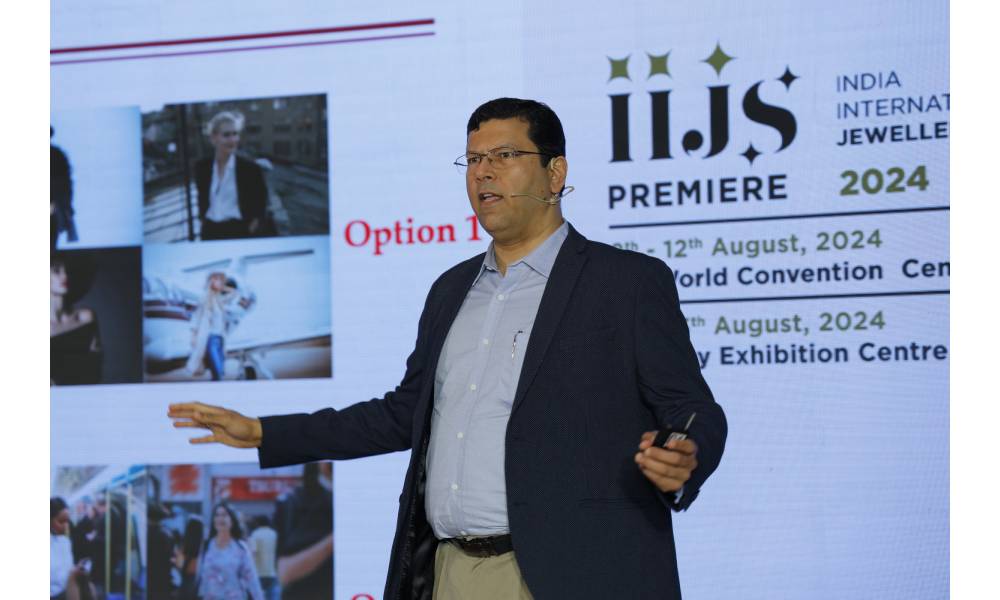In a recent industry-focused presentation given during an Innov8 Talks session at IIJS Premiere, Pranay Narvekar, Partner at Pharos Beam Consulting LLP, shared his expertise on the current and future state of the diamond market. Narvekar, a respected figure in the diamond industry, is known for his accurate forecasting and deep understanding of the market’s complexities. His session, titled “Diamond Market Fundamentals,” provided crucial insights into the challenges and trends shaping the diamond industry today.
Narvekar began by acknowledging the industry’s current struggles, likening the situation to “battling a fierce storm.” He pointed out that many in the industry are either entirely convinced of the market’s potential or have given up hope altogether. He then shared an anecdote to illustrate public perception, asking the audience to choose between two images of a woman wearing four-carat diamond studs. The responses highlighted the significant challenges in maintaining the diamond’s image as a luxury item.
Narvekar explained the “bullwhip effect,” a phenomenon where small changes at the retail level lead to amplified variations upstream in the supply chain. For example, a 15% drop in retail demand could result in a 33% decrease at the polished and jewellery level, and up to a 70% reduction in mining activity. This effect has been particularly evident in recent years, contributing to the industry’s current difficulties.
Narvekar highlighted that the industry’s current predicament was largely foreseeable. In 2022, he had warned of an impending downturn in an article titled “Winter is Coming.” The factors leading to this downturn, including the bullwhip effect, were already in motion, exacerbated by a shift in consumer spending patterns and the rise of lab-grown diamonds (LGDs).
Narvekar dedicated a significant portion of his presentation to discussing lab-grown diamonds (LGDs). He emphasised that while LGDs are a legitimate product, they are not a luxury item like natural diamonds. The inherent difference lies in the supply dynamics—LGDs are demand-driven (given that supply can be literally unlimited), unlike naturals, which are supply-driven, given the nature of the product. This distinction, Narvekar argued, undermines their potential to be seen as luxury items. He cited Karl Marx’s observation from Das Kapital on the devaluation of goods when production is easy and inexpensive, warning that LGDs could follow a similar path.
Another critical issue Narvekar addressed was the impact of sanctions, particularly on Russian diamonds. He expressed concern that these sanctions, like those imposed on Zimbabwe over a decade ago, might only benefit sanction-busters while causing further instability in the market. Additionally, he pointed out the significant influence of the US and Chinese markets on global diamond demand. The US, which consumes over half of the world’s diamond jewellery, is seeing a shift in consumer spending from goods to services. This shift, coupled with economic uncertainties, has led to a decline in diamond sales.
Despite the challenges, Narvekar offered a cautiously optimistic outlook for the future. He predicted that by the end of 2024, the market might begin to stabilise, with 2025 potentially being a more positive year. However, this depends on several factors, including the economic conditions in the US and China. Narvekar also noted that the luxury market, which had been resilient in 2023, was beginning to show signs of strain.
Narvekar concluded by emphasising the need for the diamond industry to address the demand issue seriously. He warned that the traditional approach of expecting prices to rise simply because supply might decrease is no longer sufficient. The industry must focus on maintaining the diamond’s status as a luxury item and adapt to the changing market dynamics to ensure its long-term viability.

